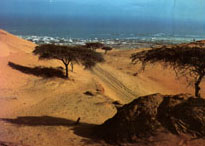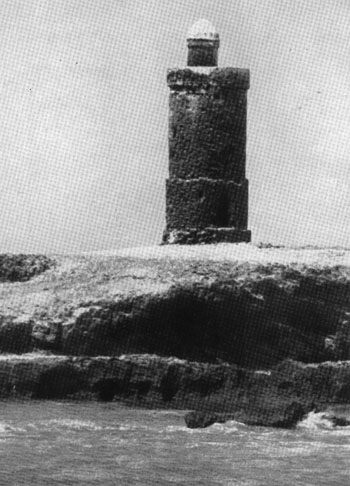|
|
Port Cities of the Horn: Barawa, Marka, Mogadishu, & Zayla
BARAWA

An ancient town on the southern Somali coast. Oral tradition relates that Aw Ali from the interior settled in a forest between arra guduud “the red dunes” and deeho “the white sands.” Aw Ali liked the freshness of the ocean air and called for help from his people in the interior to clear the forest and build several houses for him and his family. Eventually, the settlement, much of which is now under water, grew into a town named Barawa Ban Aw Ali, “Barawa, the open space of Aw Ali.” The people of Baraawe speak a language of their own known as Chimbalazi, which though it includes some Tunni, Af-Maay and Af-Mahaa vocabulary, is related, more to the northern dialect of Swahili. Local historians relate the origin of Barawaanis to Egyptians, Persians, Arabs, Indians, and even the Javanese. However, historically, Barawaanis are Wardaay (Bantu), Tunni, Wajiddu (Jiddu), Ajuraan, and Wambalazi (Galla), that is, all the various ethnicities who fought each other through the centuries. The Tunni, composed of five subclans (Da’farad, Dakhtira, Goygali, Hajuwa and Waridi), were the latest to drive the Jiddo into the interior where they established their own sultanate in Qoryooley.
The Tunni made a treaty with the Jiddu, so that they settled on the west bank of the Shabelle, and the Jiddo on the east bank. Both also agreed to resist foreign penetration, with the exception of seddah saamood “the three footprints” which are the Tunni, Jiddo and the wild beasts. However, they did accept the first Muslim migrants, the Hatimi from Yemen and the Amawi from Sham (Syria), around the 10th century, for both religious and commercial reasons. The town prospered and became one of the major Islamic centers in the Horn, the Barawani Ulama, attracting students from all over the region. Muslim scholars of the time, such as al-Idrisi, wrote about Barawa as “an Arabic ‘Islamic’ island on the Somali coast.” Al-Idrisi also described the construction of the coral houses, probably following Arab and Persian designs, and noted that Barawa market was full of both domestic and foreign commodities.
Barawa was famous for traditional crafts, such as the weaving of the Aliindi or Kikoy cloth, and hats, Kofiya Barawi, worn by dignitaries even today, traditional sandals, shields and belts, furniture, and several types of cooking pots, still locally made including the clay horned stoves seen in the heyban pottery. Barawa had a distinctive style of woodcarving and furniture making, such as the ‘Atiir “wedding bed,” the wambar (“wooden leather covered stools”) and the mihmil “Qur’an holder.” Gold and silver necklaces, bracelets and jewelry containers were produced, as were metal trunks, tea/coffee pots, iron beds, spears and arrows. Barawa is also known for its own architectural style. Wider streets and larger windows are common. Barawa, has many two story houses with bridges constructed over the streets so that women or the elderly could visit other houses without down into the street. The town was divided into major quarters each with a main Masjid. Coral was transported by camel carts and burned to make lime for buildings, a wise use of traditional skills that was more economical than using imported cement.
In 1506, Barawa was reduced to ashes by the Portuguese fleet and became a major Portuguese port, but in league with other coastal towns, it liberated itself from Portuguese rule in 1758 when it became part of the coastal alliances led by the Zanzibar Sultanate. In 1840, when the Bardheere Jama’a looking for an outlet to the sea attacked Barawa, the town was burned and the people appealed to the sultan of Zanzibar for protection. However, in 1889, Barawa fell into the hands of the Italians when the Sultan of Zanzibar was forced to agree to the annexation of the Banadir ports to the Italian colonial administration of the Horn. Barawa resisted the Italians. Sheikh Uways al-Baraawi organized his Ikhwaan and instigated the Banadir revolt, which was defeated in 1908. Sheikh Uways migrated to Biyoley to reorganize his Ikhwan but was killed in 1909. His successor Khalif Sheikh Faraj was also killed in 1925. However, the Uwaysiyya order, named after the martyr Sheikh Uways, emerged throughout southern Somalia and East Africa, establishing jama’as in the riverine region, which became strongholds of the educated elite and refuge for the disadvantaged. From these Jama'as, many influential political leaders emerged to form modern Somali political parties. Abdulkadir Sakhawuddin, the founder of the Somali Youth Club (SYC), in 1943, was not only an Uwaysi leader but also the grandson of Sheikh Uways. Barawa was the stronghold of Hizbiya Digil-Mirifle (HDM) founded in 1947. In addition to Sheikh Uways, Baraawe could boast of notable Ulama in the fields of Islamic jurisprudence, Hadith, Tafsir and Sufi literature, among them Sheikh Nureini Sabiri, Sheikh Qassim al-Baraawi, Sheikh Ma'llim Nuri and a female poet-saint, Dada Masiti.
Barawa began to decline in colonial times when advanced port facilities were established in Marka and Mogadishu. Post-independence governments also neglected the town. From 1974 Barawa suffered from the refugee settlement programs of Sablaale: over 5,000 of the 30,000 drought-stricken nomads were resettled and taught unsuccessfully agriculture and fishery as a new way of the life. The newcomers turned the urban life of Barawa to a nomadic one, and many Barawanese left town, so that it no longer had its traditional character and prosperity. During the civil war, Barawa suffered greatly from the retreating forces of Siad Barre in the early months of 1991, but the town indeed was looted and actually destroyed mostly by the marauding militia loyal to Mohamed Farah Aideed. By 1992, Barawa was a ghost town. The surviving Barawanese people ran away to settle in refugee camps, in the neighboring countries.

Barawa | Marka | Mogadishu | Zayla
Home| The West | Charting | Commerce | Madras | Picturesque | The Horn
The web sites include links to sites outside the control of the authors. The author is not responsible for information on these or other such linked sites. Please respect the copyright notices attached to the Web Sites you view.
© 2002 Mohamed Mukhtar. All rights reserved.